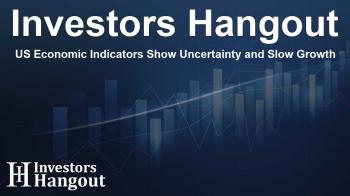US Economic Indicators Show Uncertainty and Slow Growth

US Services Sector Takes a Hit
Recent economic reports reveal a significant downturn in the U.S. services sector, igniting concerns about the overall health of private market activities. The latest S&P Global PMIs indicate startling shifts, with figures showing a marked decline.
Services PMI Experiences First Contraction Since 2023
Services PMI: The S&P Global Flash U.S. Services PMI Business Activity Index registered at 49.7 in February, down from January's 52.9. This shift is a stark departure from expectations set at 53. It also marks the first observable contraction in the services sector in over two years, signaling potential trouble ahead.
Firms have reported a chilling drop in new order growth as uncertainty overshadows decision-making. Businesses express growing apprehension regarding economic policies, which are seen as potentially inflationary and paired with administrative spending cuts. Analysts project the Services PMI could stabilize around 52 points by the close of the first quarter.
Manufacturing PMI Shows Resilience
Manufacturing PMI: Contrasting the services downturn, the U.S. Manufacturing PMI showed an uptick, moving from 51.2 points in January to 51.6 points in February, exceeding forecasts of 51.5. This suggests a continuing recovery within the sector, with factory output expanding for a second consecutive month.
This positive trend is noteworthy as it marks the highest reading since June, reflecting a somewhat optimistic outlook in manufacturing amidst broader economic anxieties. Market expectations indicate a slight easing to around 51 points by quarter's end.
Composite PMI Reveals Slowing Growth
Composite PMI: The Composite PMI, which blends the services and manufacturing indicators, fell significantly to 50.4 in February from 52.7 previously. This figure represents the slowest growth rate in the private sector since September of the previous year.
Contributory factors to this decline include reduced new orders and a slight employment contraction, compounded by rising cost inflation and the slowest increase in selling prices since late 2024.
Chris Williamson, Chief Business Economist at S&P Global Market Intelligence, emphasized that the previously optimistic sentiment seen among businesses has dissipated, replaced by a growing cloud of uncertainty, stalled activity, and heightened prices.
Market Reactions to Economic Indicators
The market's response was immediate, with all major U.S. indices closing lower. The SPDR S&P 500 ETF Trust (SPY) registered a drop of 0.49%, while the Invesco QQQ Trust (QQQ), closely following the Nasdaq 100, edged down by 0.37%.
Additionally, the Invesco DB USD Index Bullish Fund ETF (UUP), which follows the U.S. dollar index, managed a slight gain of 0.38%, trading at $29.09 at the time of the report.
Conclusion
These recent economic indicators paint a complex picture of U.S. economic performance. While the manufacturing sector shows some promise, the downturn in services poses significant risks to broader economic stability. Market players and businesses alike must navigate these uncertain waters with caution as they adapt to evolving economic conditions.
Frequently Asked Questions
What does the Services PMI indicate for the U.S. economy?
The Services PMI provides insight into the overall health of the services industry, and a reading below 50 indicates contraction, pointing to potential economic slowdowns.
How did the Manufacturing PMI perform recently?
The Manufacturing PMI increased to 51.6, signaling growth and recovery in the manufacturing sector, a positive sign amidst broader economic concerns.
Why is the Composite PMI significant?
The Composite PMI combines services and manufacturing data, providing a holistic view of economic performance and indicating general private sector growth or contraction.
What are the market implications of these economic indicators?
These indicators influence market behavior, with declines often leading to lower stock prices, as seen with the major indices reacting negatively to the latest data.
How do analysts forecast future PMI readings?
Analysts utilize global macro models and current economic data to project expected PMI readings, which can guide businesses and investors in their strategies.
About The Author
Contact Hannah Lewis privately here. Or send an email with ATTN: Hannah Lewis as the subject to contact@investorshangout.com.
About Investors Hangout
Investors Hangout is a leading online stock forum for financial discussion and learning, offering a wide range of free tools and resources. It draws in traders of all levels, who exchange market knowledge, investigate trading tactics, and keep an eye on industry developments in real time. Featuring financial articles, stock message boards, quotes, charts, company profiles, and live news updates. Through cooperative learning and a wealth of informational resources, it helps users from novices creating their first portfolios to experts honing their techniques. Join Investors Hangout today: https://investorshangout.com/
The content of this article is based on factual, publicly available information and does not represent legal, financial, or investment advice. Investors Hangout does not offer financial advice, and the author is not a licensed financial advisor. Consult a qualified advisor before making any financial or investment decisions based on this article. This article should not be considered advice to purchase, sell, or hold any securities or other investments. If any of the material provided here is inaccurate, please contact us for corrections.

